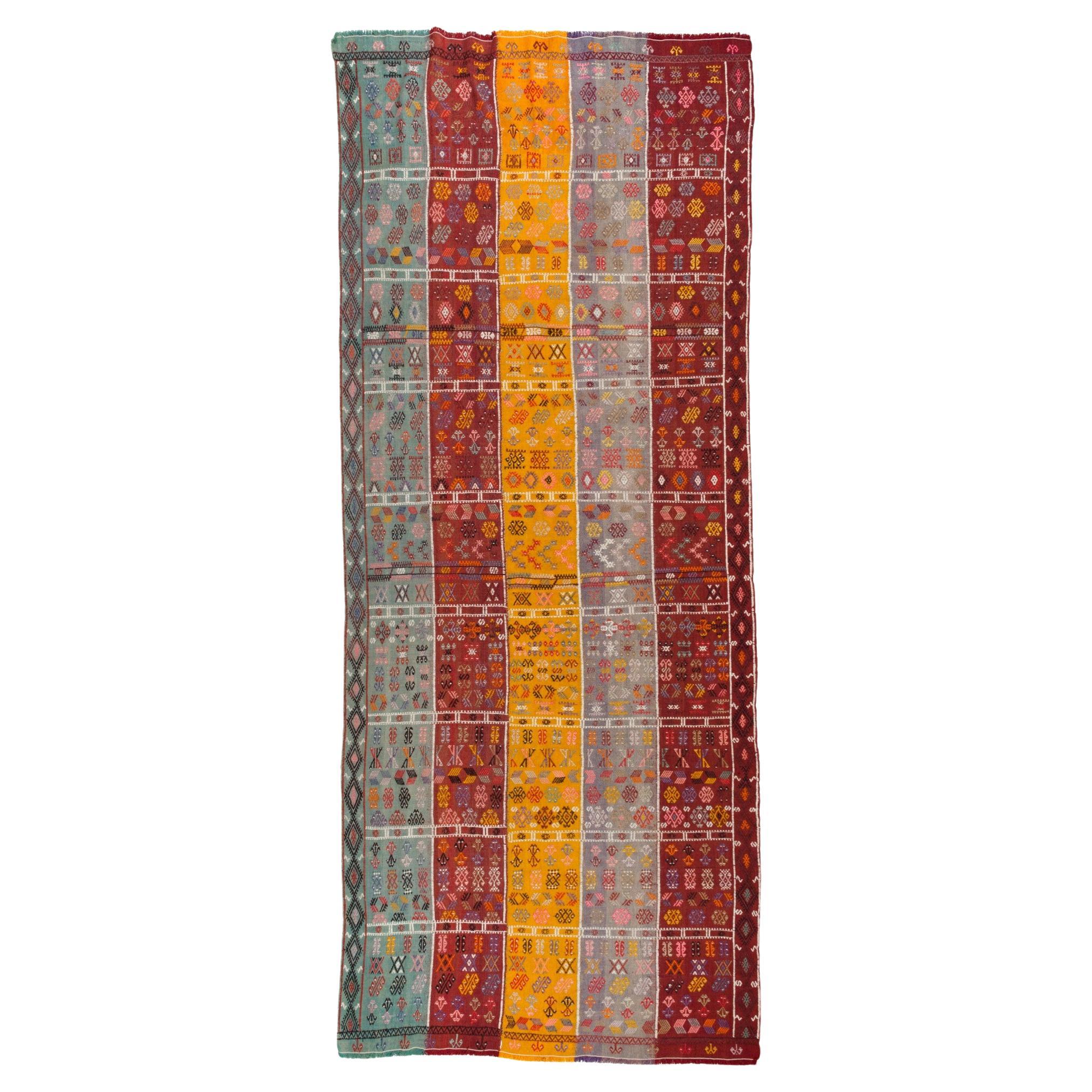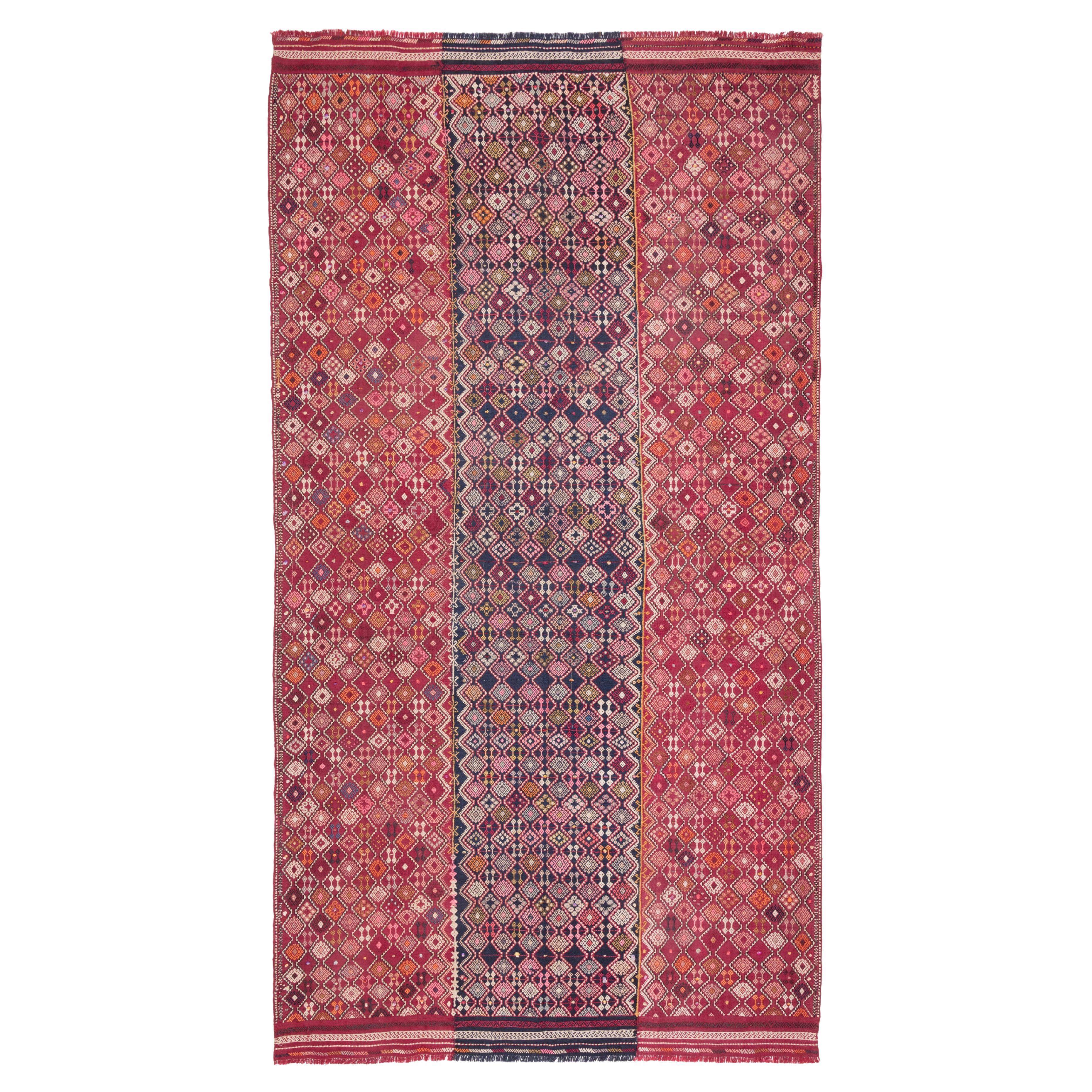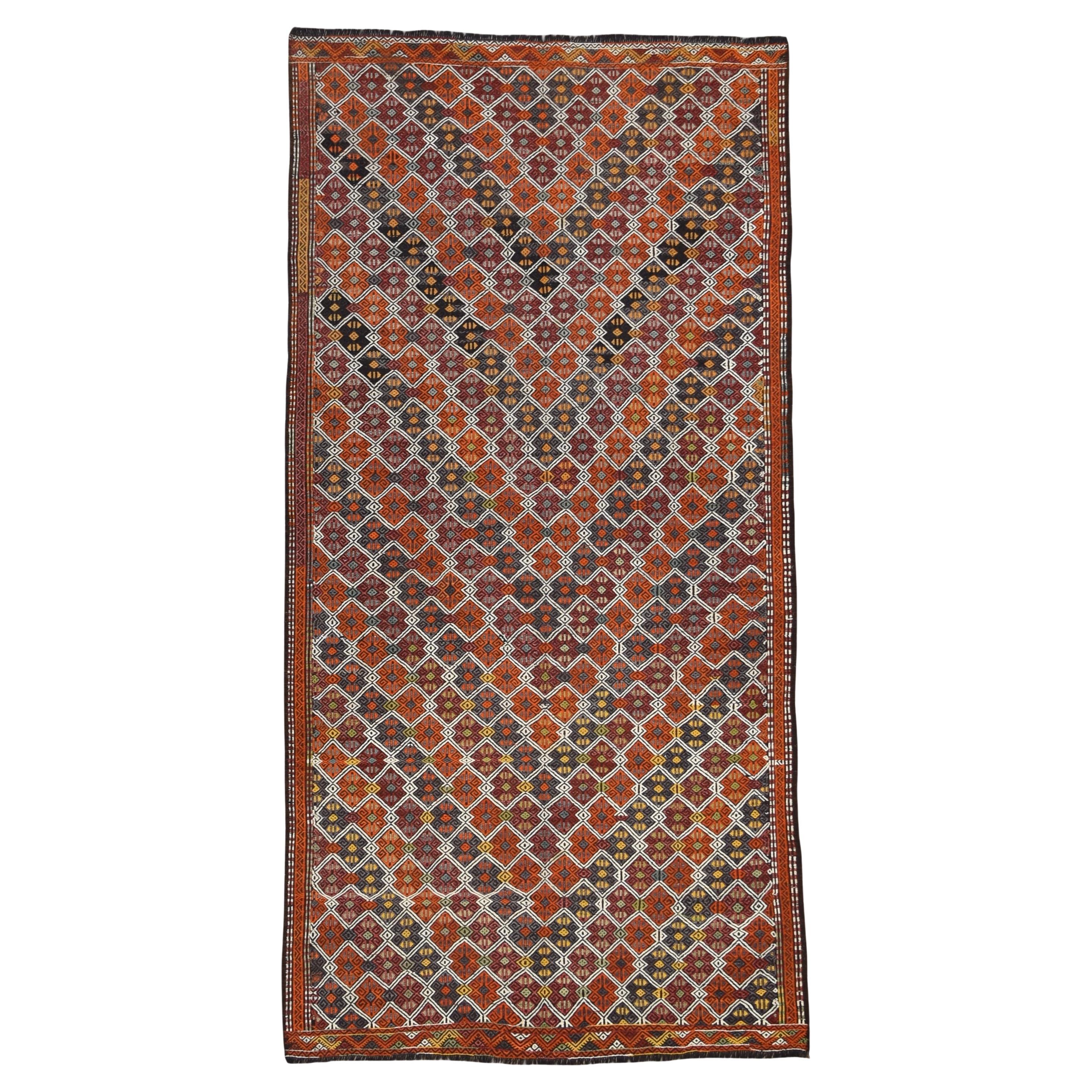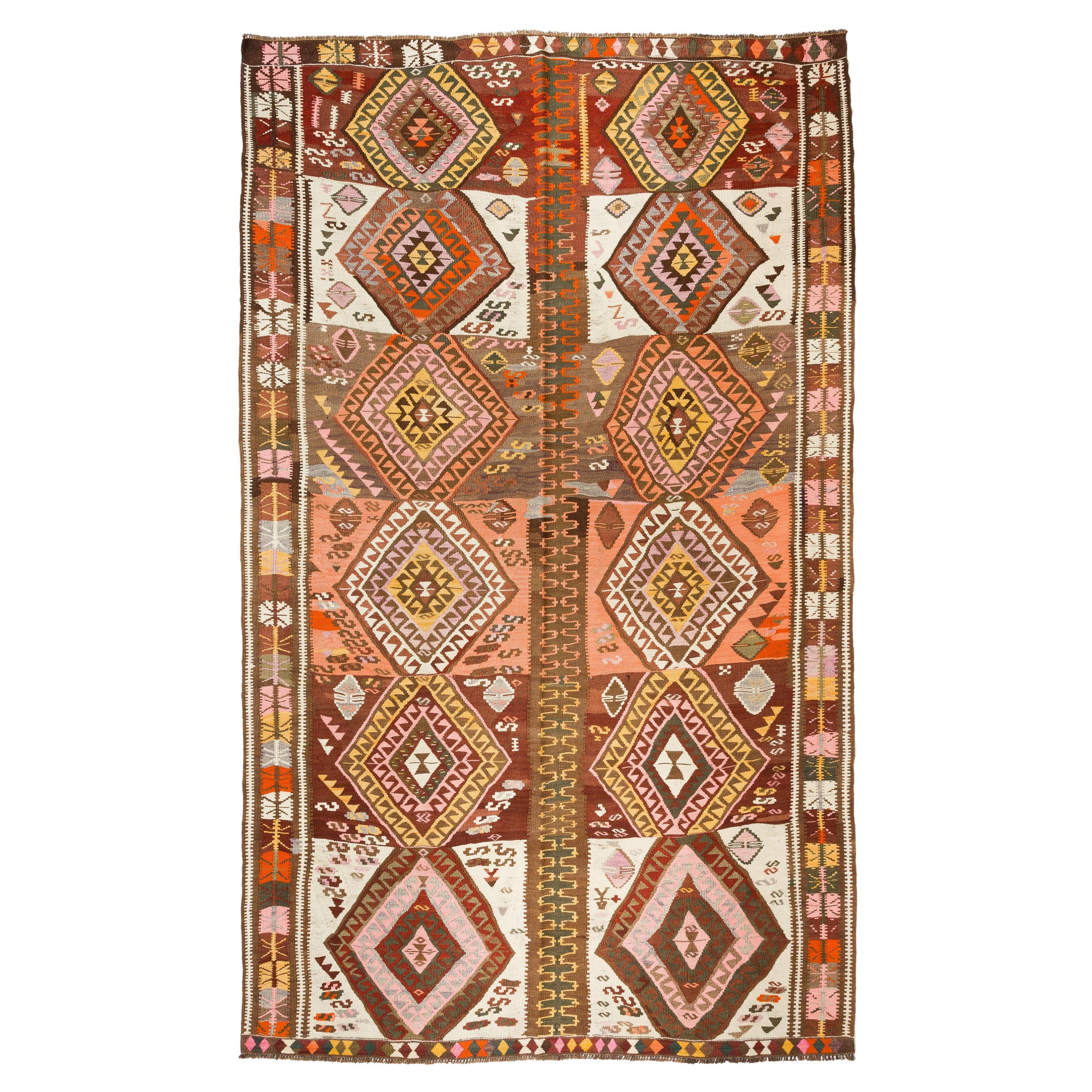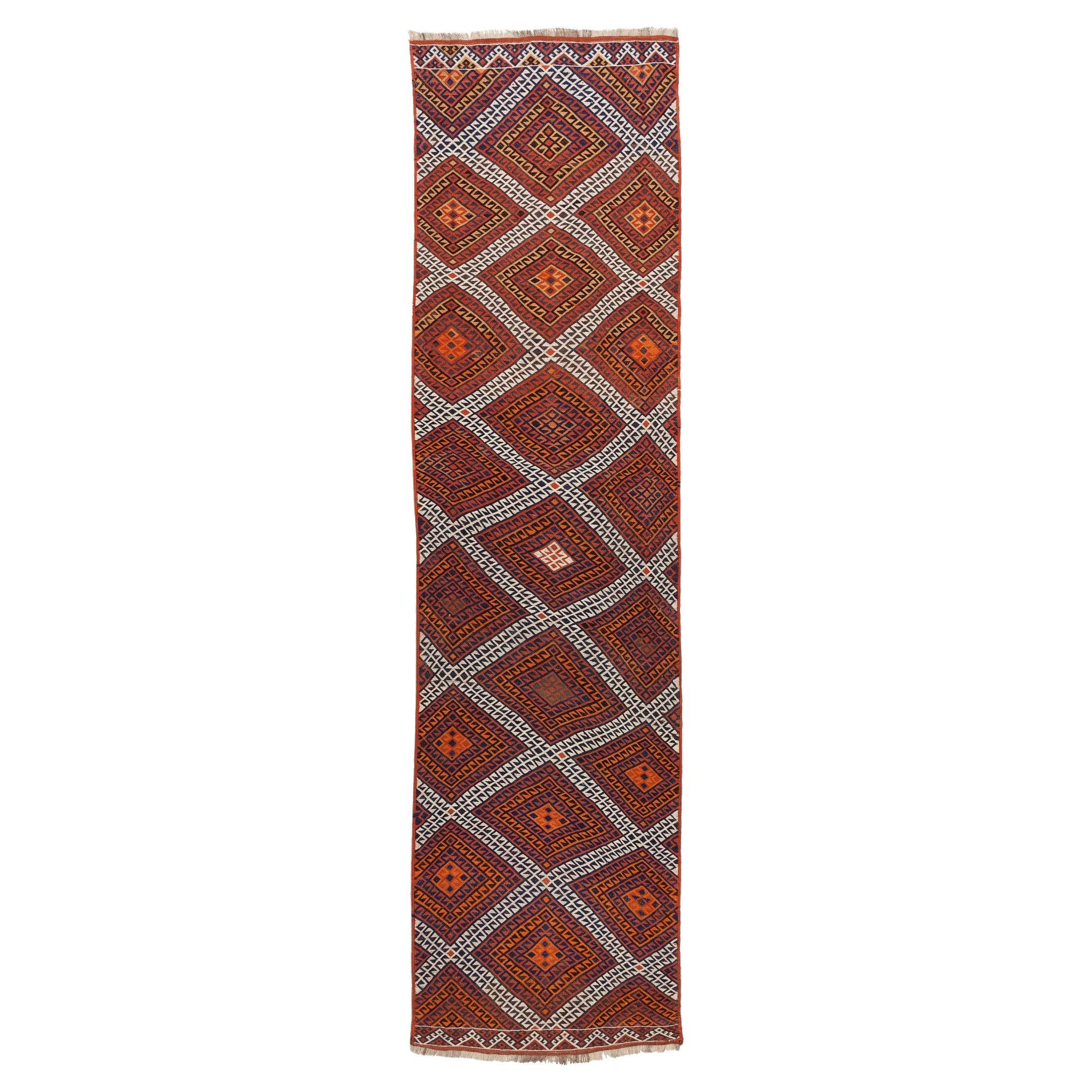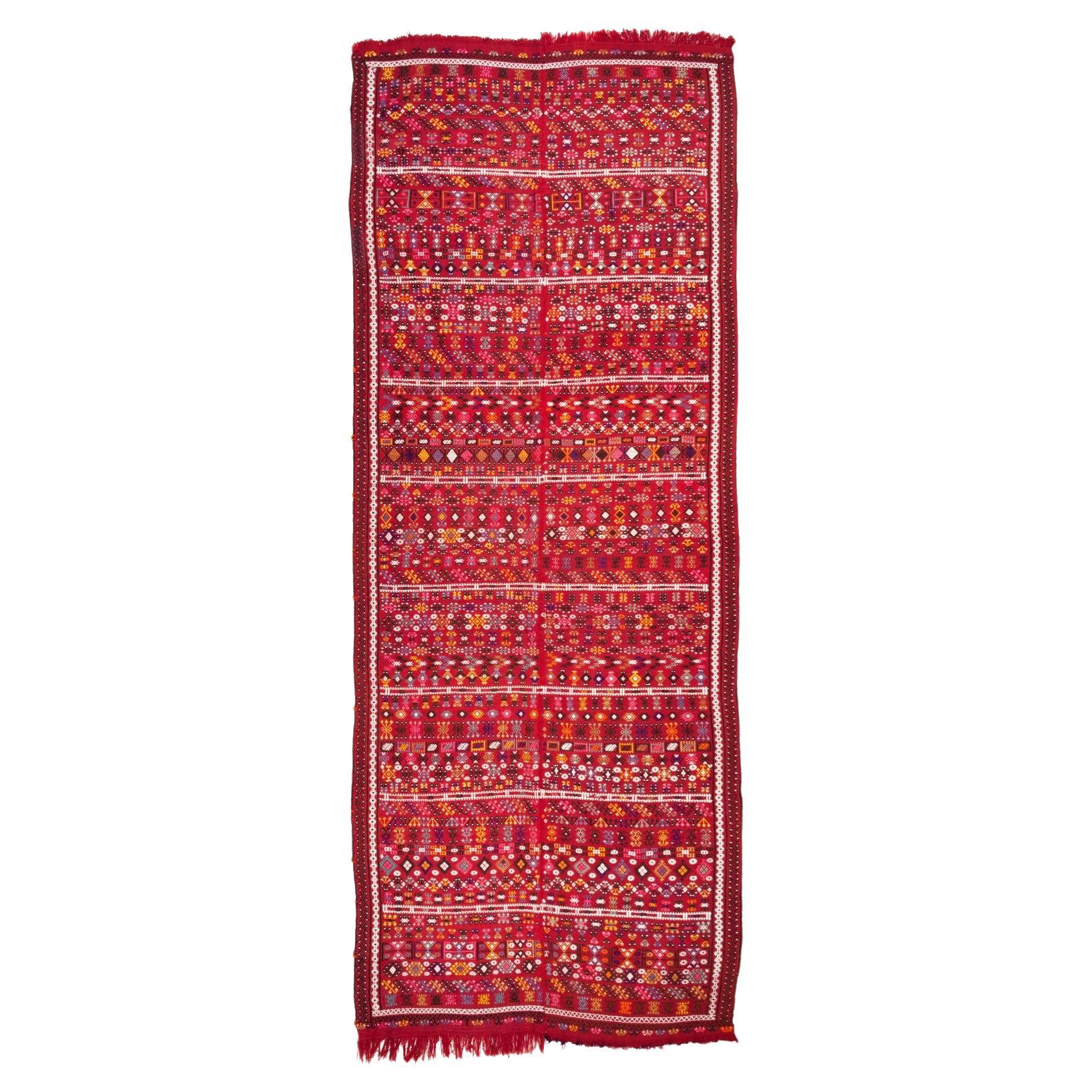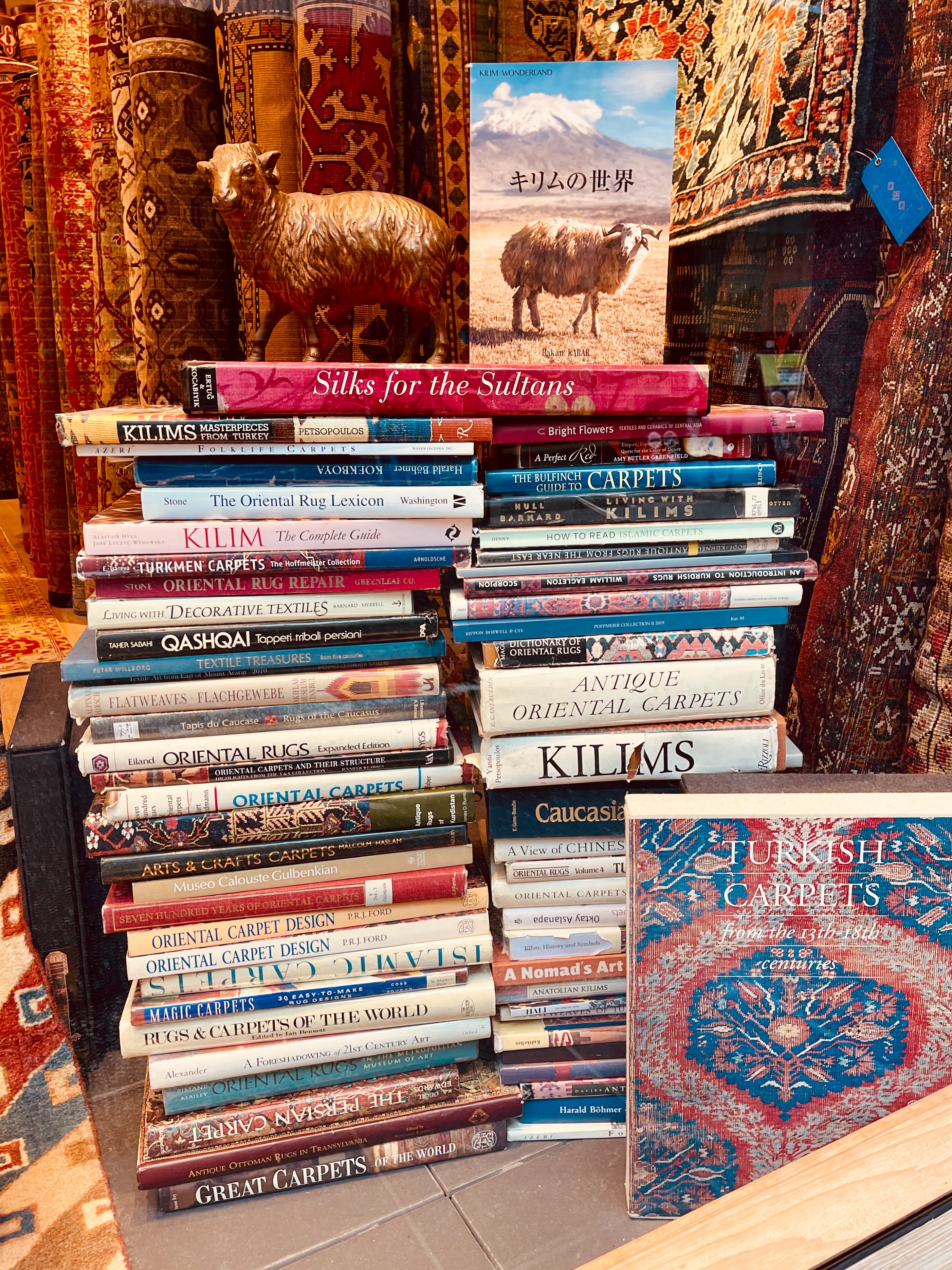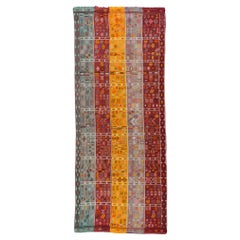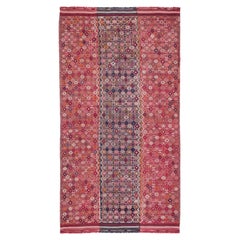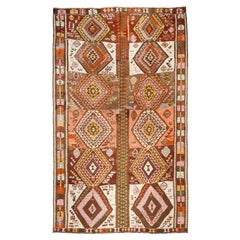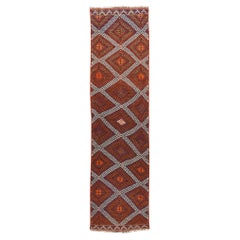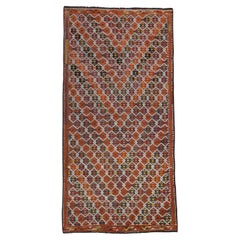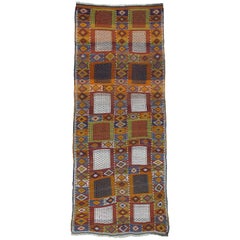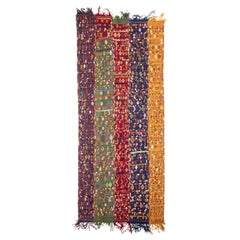Items Similar to Eastern Anatolia Old Antep Cecim Jijim Kilim Eastern Anatolia Turkish Rug
Want more images or videos?
Request additional images or videos from the seller
1 of 6
Eastern Anatolia Old Antep Cecim Jijim Kilim Eastern Anatolia Turkish Rug
$1,440
$1,80020% Off
£1,099.43
£1,374.2920% Off
€1,270.39
€1,587.9820% Off
CA$2,021.49
CA$2,526.8620% Off
A$2,253.16
A$2,816.4520% Off
CHF 1,182.15
CHF 1,477.6920% Off
MX$27,514.74
MX$34,393.4220% Off
NOK 14,968.65
NOK 18,710.8120% Off
SEK 14,147.65
SEK 17,684.5620% Off
DKK 9,481.44
DKK 11,851.8020% Off
About the Item
This is an Eastern Anatolian vintage made in two halves of old Cecim ( Cicim or Jijim) Kilim from the Gaziantep region with a rare and beautiful color composition.
This town lies in south-eastern Turkey, close to the Syrian border and the Euphrates River. Previously called Aintab and then Antep by Ottomans, Gaziantep acquired its present name after it fell to the French in April 1920, having been defended by the nationalists for ten months. This stupendous effort was recognized by the Turkish Grand National Assembly, which gave the city the prefix title of Gazi, meaning 'Defender of the Faith'. Kilim-weaving has long since ceased in this area. Gaziantep designs have horizontal bands of different colors with three diamond-shaped serrated emblems joined together to form the main pattern, often filled with star motifs, which also decorate other areas of the Kilim. These intricate designs are often highlighted with white cotton for additional effect. Borders are narrow with reciprocal designs or repeated motifs, and the fringes can be plaited or knotted. The coloring is normally dark, often with a predominance of red. Both large rectangular kilims (made in two halves) and small kilims are constructed in slitweave from finely spun wool.
- Dimensions:Width: 71.66 in (182 cm)Length: 124.81 in (317 cm)
- Style:Kilim (In the Style Of)
- Materials and Techniques:
- Place of Origin:
- Period:
- Date of Manufacture:circa 1950s
- Condition:Wear consistent with age and use. Minor fading.
- Seller Location:Tokyo, JP
- Reference Number:Seller: 234671stDibs: LU8206233322282
ARARAT RUGS
We know and believe that the geography we come from, our past, and our lifestyle are the most important bond between us to carry the oriental carpet art and culture to the next generations along with our core values in our ongoing growth journey.
We are aware that the way to achieve this goal and carry this priceless art and culture to the future depends on a lot of work with all our people every day while adhering to our core values.
For us, art is meaningful in the sense that it brings together various cultures around the world. It is an honor for us that oriental carpet art and culture have been instrumental in this for centuries and that we are a part of this business.
We are tirelessly keeping an eye on auction house information around the world about carpets. New York's Metropolitan, London's Victoria & Albert Museums, and other famous art museums, as well as small specialized museums that house private collections, and books about oriental carpets to collect information on outstanding carpet designs and patterns from around the world. It's our Self-improving and Self-developing culture.
As Turkish Culture of Hospitality, the Kurdish Culture of Generosity, and as Japanese Culture of Business Punctuality; are the most important values that this multicultural background has taught and bequeathed to us. It is essential and valuable for us that you feel this feeling not only by looking at our oriental carpets but from the moment you contact us.
About the Seller
5.0
Platinum Seller
Premium sellers with a 4.7+ rating and 24-hour response times
Established in 1970
1stDibs seller since 2023
55 sales on 1stDibs
Typical response time: 3 hours
- ShippingRetrieving quote...Shipping from: Tokyo, Japan
- Return Policy
Authenticity Guarantee
In the unlikely event there’s an issue with an item’s authenticity, contact us within 1 year for a full refund. DetailsMoney-Back Guarantee
If your item is not as described, is damaged in transit, or does not arrive, contact us within 7 days for a full refund. Details24-Hour Cancellation
You have a 24-hour grace period in which to reconsider your purchase, with no questions asked.Vetted Professional Sellers
Our world-class sellers must adhere to strict standards for service and quality, maintaining the integrity of our listings.Price-Match Guarantee
If you find that a seller listed the same item for a lower price elsewhere, we’ll match it.Trusted Global Delivery
Our best-in-class carrier network provides specialized shipping options worldwide, including custom delivery.More From This Seller
View AllVintage Old Antep Cecim Jijim Kilim Eastern Anatolia Turkish Rug Wool Carpet
Located in Tokyo, JP
This is an Eastern Anatolian vintage old Cecim ( Cicim or Jijim) Kilim from the Gaziantep region with a rare and beautiful color composition.
This town lies in south-eastern Turkey,...
Category
Mid-20th Century Turkish Kilim Turkish Rugs
Materials
Wool, Natural Fiber
$2,240 Sale Price
20% Off
Free Shipping
Vintage Old Sivas Cecim Jijim Kilim Central Anatolian Rug Turkish Wool Carpet
Located in Tokyo, JP
This is a Central Anatolian Old Vintage Handwoven Cecim (Jijim) Kilim from the Sivas region with a rare and beautiful color composition.
In the third century, Sivas was a Roman city...
Category
Early 20th Century Turkish Kilim Turkish Rugs
Materials
Wool, Natural Fiber
Vintage Kars Kilim Rug Old Anatolian Turkish Carpet
Located in Tokyo, JP
This is an Eastern Anatolian Vintage Kilim from the Kars region with a rare and beautiful color composition.
The old sector and newer southern districts of Kars are joined by a br...
Category
Mid-20th Century Turkish Kilim Turkish Rugs
Materials
Wool, Natural Fiber, Organic Material
Central Anatolian Old Runner Kilim, Wool Rug Vintage Turkish Carpet
Located in Tokyo, JP
This is Central Anatolian Vintage with a rare and beautiful color composition.
It is a long and thin runner that reaches up to three meters. What is amaz...
Category
Mid-20th Century Turkish Kilim Turkish Rugs
Materials
Wool, Natural Fiber
$2,600 Sale Price
20% Off
Free Shipping
Vintage Old Sivas Cecim Jijim Kilim Central Anatolian Rug Turkish Wool Carpet
Located in Tokyo, JP
This vintage old large kilim was woven in the Sivas region of eastern Anatolia.
The bright red woven fabric is over three meters long and is covered with beautiful kilim weaving th...
Category
Early 20th Century Turkish Kilim Turkish Rugs
Materials
Wool, Natural Fiber
$2,560 Sale Price
20% Off
Free Shipping
Vintage Old Sivas Kilim Central Anatolian Rug Turkish Natural Carpet
Located in Tokyo, JP
This is a Central Anatolian Old Kilim from the Sivas region with a rare and beautiful color composition.
Sivas In the third century, Sivas was a Roman city known as Sebastea, the capital of Armenia Minor. Flourishing under Byzantine rule, Sivas reached a peak of prosperity under the Seljuks, only to be plundered in the fourteenth century by Tamerlane, as it was an important venue on the Persian and Iraqi trade routes. The Sivas region is inhabited by Turkish and Kurdish people, and until the genocide wrought by the Turks early this century, many Armenians dwelt there as well. Sivas gained certain fame as the site for the Sivas Congress of September 1919, convened by Mustafa Kemal...
Category
Late 20th Century Turkish Kilim Turkish Rugs
Materials
Wool, Natural Fiber
You May Also Like
Vintage Şarköy Wool Kilim 5'1''x10'2''
By Amara Rugs
Located in Torrance, CA
This vibrant handwoven flatweave kilim rug is a stunning example of traditional craftsmanship, showcasing intricate tribal motifs and vivid natural dyes. This vintage piece was craft...
Category
Early 20th Century Turkish Kilim Turkish Rugs
Materials
Wool
Southeast Anatolian "Jijim, " Long Rug
Located in New York, NY
Southeast Anatolian "Jijim," long runner rug. A lovely old tribal flat-weave rug from Southeastern Turkey, possibly by Kurdish tribes, woven in the intricate "jijim" brocading techni...
Category
Mid-20th Century Turkish Kilim Turkish Rugs
Materials
Wool
Antique South East Anatolian Cicim Kilim, Mid-19th Century
Located in Istanbul, TR
Probably one of the best of its group, in rather in good condition. A collector's item. As rare as it gets.
Category
Antique Mid-19th Century Turkish Kilim Turkish Rugs
Materials
Wool
Mid-20th Century Turkish Flatweave Kilim Room Size Carpet
Located in New York, NY
This mid-20th century Turkish Flatweave Kilim rug, measuring 9' 10" x 12' 0", showcases a bold and expressive design rich with traditional tribal motifs. The rug is divided into two ...
Category
Mid-20th Century Turkish Kilim Turkish Rugs
Materials
Wool
Zabihi Collection Vintage Turkish Kilim
Located in New York, NY
Colorful mid-20th century Turkish accent size kilim
4'10' x 7'
Category
Mid-20th Century Turkish Pre-Columbian Turkish Rugs
Materials
Wool
Mid-20th Century Handmade Turkish Flat-Weave Kilim Accent Carpet
Located in New York, NY
A vintage Turkish flat-weave Kilim accent carpet handmade during the mid-20th century.
Measures: 6' 10" x 9' 7"
Flat-weave rugs & carpets:
Knotted pile rugs are just one small part of a vast universe of textile techniques suitable for heavy use. If you can imagine it, some weaver has tried it out. Pieces can be roughly divided into those reversible from the start and those never, or at least not initially, reversible. Thus, kilims are considered reversible, while everything else is not.
Kilims are tapestry woven rugs with both sides the same, in either slit technique where colors change, or with various methods of avoiding slits. Slit tapestry weave goes back to ancient times and Coptic Egyptian weavers used it for ornaments on garments and larger wall hangings. Slits can be avoided by dovetailing of colors (warp sharing) or by interlocking the wefts. The Navajo weavers of the Southwest practice the first while the Fine shawl weavers of Kashmir and Kerman employed the second. Interlocking produces a one-faced fabric, with smooth and rough, ridged faces. The typical Turkish, Caucasian, or Persian rustic Kilim shows slits, but never long ones. Aubusson French carpets are also slit tapestries and the long color transitions are sewn up as part of the regular maintenance. Some kilims are very Fine. The best antique urban Sehna (Senna) kilims on wool, cotton or silk warps approximate the comparable rugs in refinement and are the most desirable of all Persian kilims. Although the various flatweave techniques are usually expressed in geometric, simple, often repeating, patterns, Sehna kilims demonstrate that even the most intricate designs can be effectively rendered in flat-stich. The term ‘Kilim’ has been extended to cover any pileless, weft-faced heavy textile. Thus, the sectioned and joined northeastern Persian horizontally striped wool rugs are called ‘kilims’. So are the plain-weave end finishes of pile rugs. All these are weft-faced, weft patterned flatweaves.
These sectioned pieces are woven not on a frame loom, but one steadied by the weaver at one end and with the warps fastened down at the other. Only relatively recent have these tribal pieces become available. They are used as floorcoverings, hangings, room dividers, furniture covers. They are mostly bitonal in shades of natural dark brown and beige. Some more recent pieces show weaver innovations with ikat and moire effects. Work proceeds quickly and a skilled weaver can complete a thirty foot strip in almost no time.
Wefts, the elements added as weaving progresses, play an essential part in what is a flatweave. The best-known example of an extra-weft, wrapping technique is on Caucasian and tribal Persian Soumaks, where a pattern weft wraps around the fixed warp, changing as weaving progresses. Soumaks can be large carpets, Kuba in the Caucasus, small bag faces (Caucasian and Persian Shah Savan saddle bags), or cover scatter rugs (Persian Afshars). The Soumak technique is fast, and a weaver can work much more quickly than tying knots. The left-over wefts are cut off on the back, so the front and back are initially different. As a Soumak on the floor gets used, these weft yarns wear away and the two sides converge although the exact texture remains distinct.
There are other ways of pattern by weft. Often on smaller tribal pieces, the pattern weft(s) is (are) part of the weft structure, moving in an out, and holding the whole thing together. These wefts can be complementary or added (supplementary), continuous across the flatweave or cut off as they travel unneeded across the verso. Supplementary weft flatweaves are often very compact and substantial. The nomadic Turkmen and Balouch tribes employ both supplementary and complementary weft techniques on their pieces. Supplementary wefts are often raised on the recto (front) while complementary wefts are flat to the surface. Tribal Kurds employ this extra-wefting technique. The Balouch of Pakistan use complementary wefts almost exclusively on their small woven paraphernalia like salt bags.
Flatweave techniques may be combined on a single piece. Afshar rugs employ plain-weave end strips, preceded by Soumak bands, with pile sections between. The large Bakhtiari saddlebags feature Soumak work, pile “islands” an areas of plain-weave. Qashqai rugs and kilims frequently displays checkerboard end strips in continuous, complementary wefting.
Another distinct flatweave type is the jajim (jijim, cecim) in which a pattern is added with colored wefts as the weaving of the plain-weave ground progresses. Here the wefts are discontinuous and the pattern stands proud from the voided ground. Often made in two pieces on narrow looms and edge-sewn together, these may have geometric patterns. The term ‘jajim’ also refers to the assembled warp-faced strip and stripe covers from the Shah Savan of northwest Persia, the pattern is defined by warps alone, usually in plain stripes, but sometimes in designs of ladders, snakes, human figures and various animals. Here the color changing warps are continuous. Most are wool, a few are silk. Better to call these something else.
Indian ‘Dhurries’ are all cotton kilims and ‘shatrangis’ employ wool wefts on cotton warps. Dhurries are slitless. The cotton texture is more appropriate to the humid and warm climate of the Indian subcontinent. Modern Dhurries...
Category
Mid-20th Century Turkish Tribal Turkish Rugs
Materials
Wool
More Ways To Browse
Star Ottoman
Small French Ottoman
Large Rectangular Ottoman
Coffee Table 36 X 36
Danish 1930s Chair
Large Round Dining Tables
Orange Leather Chair
Glass Gold Leaf Plate
Harvey Schwartz Table
Iconic Bench
Marble And Gold Coffee Tables
Red Velvet Frame
Stump Furniture
Turned Ring Legs
Vintage Sheepskin Chair
Vintage Sterling Silver Objects
18th Century Italian Console
Art Deco Marble Dining Tables
